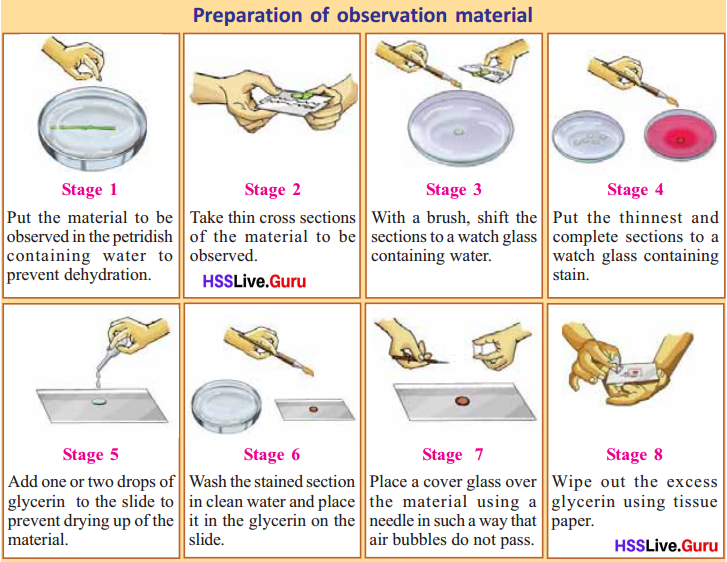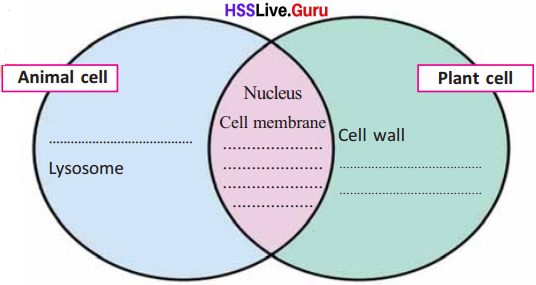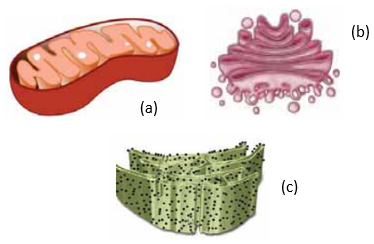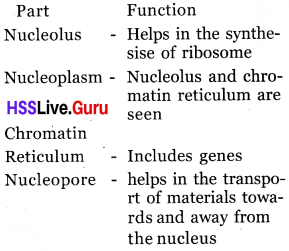You can Download life’s Mysteries in Little Chambers Questions and Answers, Summary, Activity, Notes, Kerala Syllabus 8th Standard Basic Science Solutions Chapter 1 help you to revise complete Syllabus and score more marks in your examinations.
Kerala State Syllabus 8th Standard Basic Science Solutions Chapter 1 life’s Mysteries in Little Chambers
life’s Mysteries in Little Chambers Questions and Answers
Microscope

The Microscope is a device used to magnify objects. The main parts of a microscope are Eye piece, Knobs, Objective Lens, Stage and clip, Diaphragm, Mirror etc.
The microscopes in which more than one lens is used are called compound microscopes: In a microscope there are two planes for the regulation of light. A plane mirror to reflect the sunlight and a concave mirror to reflect artificial light. The lens of the condenser that is fitted on the lower side of the stage focuses light on the material to be observed. Diaphragm regulates the intensity of light.
Indicators (Text Book Page No:9)
Life’s Mysteries In Little Chambers Kerala Syllabus 8th Question 1.
Why is a mirror fixed in a microscope?
Answer:
The Mirror is fixed to focus light on the objects to be observed.
Kerala Syllabus 8th Standard Biology Notes Question 2.
Why do we use a slide made of glass to place the material to be observed?
Answer:
A transparent surface is required to pass light of the material to be observed. So glass slide is used to place it.
Magnification Power of Microscope

Magnification Power is marked as tox and 45X in the objective lens and eyepiece. The magnification power of a microscope is the product of the numbers seen in the objective lens and eyepiece.
Preparation of Observation Material
Following are the steps in the preparation of a slide to observe plant cells.

- Put the observable material in a petridish containing water to prevent dehydration.
- Take thin cross sections of the material
- Put the sections to a watch glass con-taining water.
- Put the thinnest and complete sections to a watch glass containing stain.
- Add one or two drops of glycerin to the slide to avoid drying up of the material.
- Wash the stained section with clean water and place it in the glycerine on the slide.
- Put a cover glass over the material.
- Wipe out the excess glycerin using tissue paper.
Discovering of Cell
Robert Hooke discovered cells for the first time. The branch of science that deals with cells is called cell biology. The re markable findings that paved way for the development of cytology and the concerned scientists are indicated below.
- Robert Brown – Discovered Nucleus (1831)
- M. J. Schleiden – Discovered Plant Cells (1838)
- Theodor Schwann- Discovered Animal Cells (1839)
- Rudolf Virchow – Inferred that new cells arise only from existing cells (1858)
8th Class Biology Notes Pdf Kerala Syllabus Cell Theory
M.J. Schleiden and Theodor Schwann are the founders of cell theory. Mainly two concepts are put forward by cell Theory.
- All living body is made up of cells.
- Cells are the structural and functional units of organisms.
8th Class Biology 1st Chapter Kerala Syllabus Question 3.
What are the functions performed by cells?
Functions of Cells

- Resist foreign particles,
- Synthesis biomolecules.
- Release energy from nutrients
Structure of cell is suitable to perform various biological functions. There are different parts inside the cell for this purpose.
- Nucleus – Centre of the cell.
- Ribosome – Helps in protein synthesis
- Chloroplast – Helps in photo synthesis
- Mitochondrion – Centre of energy production, storage and distribution.
- Vacuole – Stores water, salts, excretory materials etc.
- Golgi complex – Stores enzymes, hormones, mucous etc in small vesicles.
Basic Science Class 8 Pdf Notes Kerala Syllabus Question 4.
Complete the illustration given below related to different kinds of organelles.

Hss Live Guru 8th Biology Kerala Syllabus Nucleus

Innumerable life processes take place within the cell. The biomolecules that control and coordinate these processes are synthesized under the control of the genes in the chromatin network of the nucleus.
Major parts of the nucleus are nucleoplasm, nuclear membrane, chromatin reticulum, nuclear pore, nucleolus etc.
Nucleoplasm is the fluid part of the nucleus. Nuclear membrane is the double-layered membrane that surrounds the nucleus. The minute pores in the nuclear membrane are called nuclear pores. The spherical nucleolus seen in the nucleus play a major role in the synthesis of ribosome. The chromatin reticulum seen as a network in the nucleoplasm encloses genes.
Prokaryotes and Eukaryotes
There is no definite nucleus in the cell of bacteria, cyanobacteria and mycoplasma etc. There are called prokaryotes. But in the cells of amoeba, plants, and animals a well defined nucleus is present. These organisms are called eukaryotes.
Biological Membranes
Cells are covered by membranes. They regulate the exchange of materials between cells and between cell organelles and cytoplasm. These membranes are called selectively permeable as they pass only the essential materials across them.
Indicators (Text Book Page No: 17)
Kerala Syllabus 8th Standard Physics Notes Question 5.
Plastids in the plant cells.
Answer:
Plastids are the cell organelles that are found only in plant cells. They are of 3 types – Chromoplast, Chloroplast and Leucoplast.
Class 8 Science Notes Kerala Syllabus Question 6.
Pigments in the chromoplasts.
Answer:
The pigments in Chromoplast are Xanthophyll (yellow), Carotene (yellowish Orange), Anthocyanin (Red, Purple) etc.
Kerala Syllabus 8th Standard Biology Notes Malayalam Medium Question 7.
Chromoplasts and sunlight.
Answer:
Chloroplast performs photosynthesis in the presence of sunlight. As the fruits ripen, the chloroplast in them changes to chromoplasts.
Class 8 Chemistry Chapter 1 Kerala Syllabus Question 8.
Change of colour and taste in fruits
Answer:
In the storage cells, leucoplasts are more. But as the fruit ripens the chlo- roplasts converted to chromoplasts. Starch changes to sugars. This is the reason behind the change in colour and taste when the fruit ripens.
life’s Mysteries in Little Chambers Let us complete the illustration (Text Book Page No: 18)
8th Class Biology Notes Pdf Malayalam Medium Question 1.
Compare the plant cell and the animal cell and complete the illustration given below.

Answer:

life’s Mysteries in Little Chambers Let us assess (Text Book Page No: 19)
Hsslive Guru 8th Class Biology Kerala Syllabus Question 1.
Complete the concept map related to the structure of animal cells.

Answer:

Std 8 Biology Notes Malayalam Medium Question 2.

(i) Identify the parts A,B, C,D,E marked in the plant cell.
Answer:
A – Chloroplast
B – Mitochondrion
C – Ribosome
D – Vacuole
E – Nucleus
(ii) Write the function of the parts denoted by the letters given below.
Answer:
A – Photosynthesis
B – Production, Storage and distribution of energy
C – Protein synthesis
(iii) In which part of the cell are genes found?
Answer:
Genes are seen in the chromatin reticulum in the nucleus.
life’s Mysteries in Little Chambers Additional Questions and Answers
Basic Science Class 8 Solutions Kerala Syllabus Question 1.
Find the odd one in each group. Also write the common characteristics of the others.
a. Bacteria, Cyanobacteria, Amoeba, Mycoplasma,
b. Golgi complex, Ribosome, Lysosome, Mitochondrion
c. Mitochondrion, Cell membrane, Ribosome, Golgi complex
d. Xanthophyll, Anthocyanin, Tonoplast, Carotene
Answer:
a. Amoeba; The others are prokary otes.
b. Lysosome; The others are present in both plant and animal cell.
c. Cell Membrane; Others are cell organelles
Kerala Syllabus 8th Standard Basic Science Textbook Solutions Question 2.
Find out the relation between the given word pairs and on that basis fill in the blanks.
a. M.J. Schleiden- ………… ; Theodor Schwann- Animal cell
b. Power house – Mitochondrion; Skeleton of cell- …………
c. Bacteria – ………… ; Amoeba – Eukaryote
d. Robert Hooke – Cell; ………… – Nucleus
e. Yellowish orange colour – Ca-rotene; Yellow colour – …………
f. Powerhouse of the cell – Mitochondrion; Transport of materials – …………
Answer:
a. Plant Cell
b. Endoplasmic reticulum
c. Prokaryote
d. Robert Brown
e. Xanthophyll
f. Endoplasmic reticulum
Basic Science Class 8 Chapter 1 Question Answer Question 3.
Copy the given figure, then identify and mark those parts, their features are given.|

a. Cytoskeleton
b. Controll various process inside a cell
c. Power house of cell
Answer:
a. Endoplasmic reticulum – understand, marking
b. Nucleus – understand, marking
c. Mitochondrion – understand, marking
Question 4.
It was Rudolf Virchow who dis-covered one of the prominent characteristics of cell. Analyse the statement.
Answer:
He found the process cell division. New cells are formed only from existing cell.
Question 5.
Which components of plant cell are not found in animal cell?
Answer:
Centrosome, Lysosome.
Question 6.
Some components of Animal cell are also found in the plant cell. List out them.
Answer:
Cell wall, large vacuole, plastids.
Question 7.
What change occur when a mango ripens? What are the causes?
Answer:
Colour changes.
Chloroplast is changed into chromoplast.
The sour taste is changed sweet taste. Starch is changed into sugar.
Question 8.
Choose the parts of microscope from the following terms.
| Diaphragm, test tube, objective lens, eye piece, mirror, hammer, watch glass, cover glass, knobs, stage, clip |
Answer:
Diaphragm, objective lens, eye piece, mirror, Knobs, Stage, Clip
Question 9.
Make a table showing the different parts of microscope and their function.
Answer:
Eye piece – helps to magnify objects; helps to observe objects
Knobs – to adjust the position of lens
Objective lens – helps to magnify objects
Stage & Clip – object is placed on the stage and the slide is fixed using clips
Diaphragm – helps to reduce the intensity of light Mirror – reflects sunlight
Question 10.
Why does mirror is fixed in the microscope?
Answer:
To allow sunlight on to the material observed.
Question 11.
Why a glass slide is used to place the material to be observed?
Answer:
A transparent surface is needed to fall sunlight reflected by the mirror on the material to be observed.
Question 12.
Why plane mirror and concave mirror are used in the microscope?
Answer:
Plane mirror reflects sunlight.
Concave mirror reflects artificial light.
Question 13.
Ananthu noted the markings 10x and 45x in the objective lens of the microscope. He also noted the markings on the eyepiece too. But he couldn’t understand this? Can you help him?
Answer:
These markings (10x, 45x) denote their magnification power.
Question 14.
How can we find out the magni-fication power of microscope?
Answer:
The product of the numbers seen in the objective lens and eyepiece de-notes its magnification power.
Question 15.
What is the difference between simple microscope and compound microscope?
Answer:
In simple microscope there is only one lens. But in compound micro-scope there are more than one lens.
Question 16.
Why the sections of plantain roots are put in the water taken in the petridish?
Answer:
To avoid dehydration of roots.
Question 17.
Anagha and Priya placed the sections of plantain root on glass slides. After sometime the materials on Anagha’s slide dried up. But Priya’s slide was suitable for observation. What may he the reason for this?
Answer:
To avoid drying up it is needed to add a few drops of glycerine on slide. Priya has done it.
Question 18.
Write procedure for observation of the section of plantain root.
Aim – to observe the cells in the roots of plantain.
Materials required -Plantain root, Petridish, Blade, Brush, Glass slide, Cover slip, Stain, Glycerine, Water, Microscope.
Procedure: –
Answer:
- Take thin sections of the roots of plantain. Put it in the water in a petridish.
- Transfer the sections to the water taken in a watch glass using a brush.
- Put the thinnest and complete sections in a watch glass containing stain.
- Add a few drops of glycerine on slide to avoid dehydration.
- Place the stained section on the slide after putting it in fresh water.
- Cover it using a cover glass to avoid air bubble.
- Wipe out the excess glycerine using a tissue paper.
Question 19.
Match the Scientists and their contributions.
Rudolf Virchow – a. Found out that plant body is made up of cells.
M. J. Schleiden – b. Observed cells for the first time.
Robert Hooke – c. Found out that animal body is formed of cells.
Robert Brown – d. Formulated the inference that new cells form only from the existing ones.
Theodor Schwann – e.Invented nucleus.
Answer:
Rudolf Virchow – b
M. J. Schleiden – a
Robert Hooke – b
Robert Brown – e
Theodor Schwann – c
Question 20.
State Cell theory
Answer:
All living body is formed of cells. Cells are the structural and functional units of organisms.
Question 21.
Who are the founders of Cell Theory?
Answer:
MJ. Schleiden and Theodor Schwann.
Question 22.
“Our body is composed of millions of cells. Why these much of cells?” – Ananthu
‘They have various functions to perform’ – Bhadra
List out the functions of cells in the body.
Answer:
- Defend foreign particles.
- Releases energy from the cells.
- Synthesis biomolecules.
Question 23.
Classify the given cell organelles under suitable headings. Common terms can be included in both groups.
Ribosome, Nucleus, Cell membrane,Centrosome, Chloroplast, Vacuole, Golgi Complex, Mitochondrion, Lysosome
Answer:
| Plant cell | Animal cell |
| Cell wall | Centrosome |
| Chloroplast | Lysosome |
| Vacuole | Ribosome |
| Ribosome | Nucleus |
| Nucleus | Golgi complex |
| Golgi Complex | Mitochondrion |
| Mitochondrion | Cell membrane |
| Cell membrane |
Question 24.
Identify the cell organelles that perform the functions mentioned below.

- Encloses enzymes, hormones etc in small vesicles
- Gives strength and shape to cells.
- Power house of the cell.
Answer:
- b. Golgi complex
- c. Endoplasmic reticulum
- a. Mitochondrion
Question 25.
Complete the labelling of the given diagram of plant cell suitably.

Answer:
a. Nucleus
b. Centre of protein synthesis in the cell
c. Mitochondrion
d. Power house of the cell
Question 26.
Complete the illustration given below.
Vacuole, Mitochondrion, Endoplasmic Reticulum, Golgi complex

Answer:
Vacuole – Stores water, salts, and waste materials.
Mitochondrion – Power house of the cell, helps in the production and storage of energy.
Endoplasmic Reticulum – Pathway inside the cell. Provide rigidity and shape to cells.
Golgi Complex – Encloses enzymes, hormones & mucus in small vesicles.
Question 27.
While discussing about the cell Kunchu has a doubt” Are Protoplasm and Cytoplasm one and the same?” What is your response?
Answer:
Protoplasm constitutes all materials within the cell membrane. Cytoplasm is the part of protoplasm except the nucleus.
Question 28.
What is the difference between simple microscopes and electron microscopes?
Answer:
Simple Microscope
- Magnifies an object 2000 times its actual size
- Light source is used to see objects Electron Microscope
- Magnifies objects million times
- Electrons are utilized instead of light source.
Question 29.
Complete the table showing dif-ferent parts of nucleus and their functions.
Answer:

Question 30.
“Can organisms live without a definite nucleus”? I can’t believe it. Have you noticed Gopika’s doubt? How will you clarity this doubt?
Answer:
There are certain organisms without a definite nucleus. In bacteria, cyanobacteria and mycoplasma, there is no nucleus. They are called prokaryotes.
But in the cells of Amoeba, animals and plants there is a well defined nucleus covered with membrane. These are known as eukaryotes.
Question 31.
Complete the given flow chart.

Answer:
a – Chloroplast
b – Leucoplast
c – Imparts colour to fruits and flowers.
Question 32.
Why do the cell membranes called selectively permeable membranes?
Answer:
Hence they allow only the essential materials to pass through.
Question 33.
How does the colour of fruits change when they ripen?
Answer:
As fruits ripens, the chloroplasts get converted to chromoplasts. Thus colour changes.
Question 34.
Describe the function of Centrosomes.
Answer:
Centrosomes is the cell organelle that is found only in animal cells. The centrioles that play a major role in cell division. It helps to the formation of spindle fibers.
Question 35.
Find out statements which are relate to animal cells from the following statements.
• seen cell wall.
• seen cell membrane.
• seen mitochondrion.
• seen vacuole and chloroplast.
Answer:
• seen cell membrane.
• seen mitochondrion.
Question 36.
How spindle fibres are formed in plant cells and fungus cells?
Answer:
In plant cells and fungus cells spindle fibres are formed through microtubule organising centre.
Question 37.
Why are biomembranes known as selectively permeable membrane?
Answer:
The exchange of materials between cells and between cell organelles and cytoplasm occurs through biomembranes. These membranes do not allow all but some materials to pass. Hence they are selectively permeable membrane.
Question 38.
The discovery of electron microscope enables the detailed study on the cells easy. How?
Answer:
The electron microscope can magnify an object into millions of time of the original size. So it helps to understand more about the micro structures of the cell.
Question 39.
What are unicellular organisms? Write examples for this?
Answer:
Some organisms have only a single cell in their body. Such organisms are called unicellular organisms,
eg: Amoeba, Paramoecium and Euglena.
Question 40.
What are multicellular organisms?
Answer:
There are a number of cells in the body of these creatures. They are therefore know as multicejlular organisms.
Question 41.
What is cell wall?
Answer:
Cell wall is the covering seen outer to the plasma membrane in plants. It is composed of cellulose. It has numerous pores. Movement of molecules is possible through these pores.
Question 42.
How do animal cells differ from the plant cells in structure?
Answer:
Plant cell and animal cell are often structurally same. But the plant cell is surrounded by a rigid protective cell wall formed of cellulose. Cell wall is the major factor by which we can identify the animal cells from plant cells. In plant cell large vacuole and chloroplasts are seen.
Question 43.
Draw the diagrammatic repres-entation of animal cells and plant cells and illustrate the parts?
Answer:
Animal cell

Plant cell
